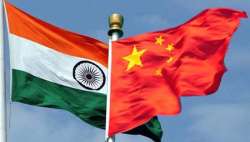China says will maintain communication with India on artificial lakes
According to reports, three huge artificial lakes were formed in the Brahmaputra river, locally known as the Yarlung Tsangpo, due to landslide after a 6.4-magnitude earthquake in Tibet last month.

China will maintain communication with India to deal with massive lakes formed by landslides on the Brahmaputra river in Tibet following an earthquake, which caused concerns of a sudden flooding on the Indian side, a Foreign Ministry official said today.
According to reports, three huge artificial lakes, whose size and volume of water in them are yet to be ascertained, were formed in the Brahmaputra river, locally known as the Yarlung Tsangpo, due to landslide after a 6.4-magnitude earthquake in Tibet last month.
The massive accumulation of water has caused concerns that if the lakes join or burst, millions of people residing along the banks of both Siang (in Arunachal Pradesh) and Brahmaputra (in Assam) downstream could get affected.
"The Chinese side, through the existing channels, will maintain communication with the Indian side on the cross- border rivers," Chinese Foreign Ministry spokesperson Hua Chunying told media persons here.
She said verification by the Chinese authorities has revealed that lakes are on the eastern section of the India- China boundary.
"It is caused by natural factors. It is not a man-made accident. I noticed that authorised Indian professionals have made an analysis and clarified," she said, referring to reports of the lakes being detected by satellites.
"We hope the Indian media will not make a groundless speculation on this," she said.
She said the Chinese officials concerned will maintain communication with the Indian side on the issue.
Earlier, China had refuted reports that the highly-polluted water in the Siang river was caused by attempts to build a massive tunnel to divert the water to neighbouring arid Xinjiang region.
The issue was reportedly discussed during the recent 20th border talks between NSA Ajit Doval and Chinese State Councillor, Yang Jiechi on December 22 in Delhi.
The India-China border dispute covers the 3,488 km long Line of Actual Control (LAC). While China claims Arunachal Pradesh as Southern Tibet, India asserts that the dispute covered Aksai Chin area which was occupied by China during the 1962 war.